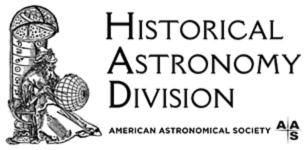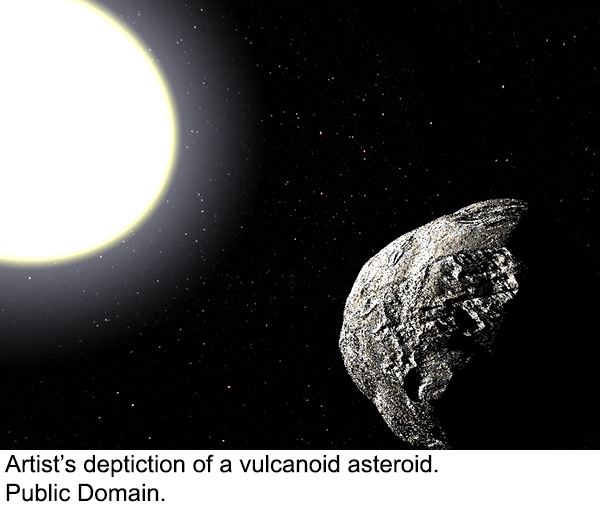This Month in Astronomical History: Relativity and Vulcan’s Vanishing Act
Teresa Wilson United States Naval Observatory
 Each month as part of this new series from the Historical Astronomy Division of the AAS, an important discovery or memorable event in the history of astronomy will be highlighted. This month, we look at the non-existent planet Vulcan and its connection to relativity.
Each month as part of this new series from the Historical Astronomy Division of the AAS, an important discovery or memorable event in the history of astronomy will be highlighted. This month, we look at the non-existent planet Vulcan and its connection to relativity.
 Total solar eclipses, like the one that will be visible across the US on 21 August, have historically provided astronomers with unique opportunities for observing the Sun or near-Sun objects. This is the story of a near-Sun planet that was, in fact, not there at all.
Total solar eclipses, like the one that will be visible across the US on 21 August, have historically provided astronomers with unique opportunities for observing the Sun or near-Sun objects. This is the story of a near-Sun planet that was, in fact, not there at all.
In the early 1800s, everyone in the scientific community was standing on the shoulders of such giants as Galileo, Kepler, and Newton. Their works gave astronomers the means and the mathematics to predict the motions of planetary bodies almost exactly. When predictions deviated from observations, astronomers adjusted their models, sometimes adding more planets to the solar system; that is the story behind Neptune’s discovery in 1846. When astronomers turned their telescopes to Mercury to monitor and model its orbit, they discovered it was not quite what they expected and turned once again to their trusted giants to understand why.
Precession, or the slow gyration of a planet’s orbital major axis, was the source of the problem. Applying Newtonian mechanics to the celestial bodies had modeled this phenomenon very nicely, but Mercury’s orbit did not follow the predictions all of the time. After the French astronomer Urbain Jean Joseph Le Verrier had successfully used similar perturbation methods on Uranus’ orbit to theorize Neptune’s existence, he applied the same approach to Mercury. In September 1859, he announced that a planet or a group of asteroids must exist between Mercury and the Sun. He hypothesized that it orbited about halfway between Mercury and the Sun, was about the same size as its planetary neighbor, and would most likely be seen during a total solar eclipse. Meanwhile, Edmond Lescarbault, a country doctor and amateur astronomer, had witnessed what he thought was a transit of an unknown planet in March 1859. It wasn’t until December that he thought to contact Le Verrier about his findings. Le Verrier trekked out to the countryside to learn what he could of the man and his purported sighting. Judging it legitimate, Le Verrier announced that Lescarbault had discovered a new planet. By February 1860, he christened it Vulcan, after the Roman god of fire. Attempts to see the planet from Spain and Algiers during the 1860 eclipse failed, much to everyone’s disappointment. For the next decade, claims of Vulcan sightings were ubiquitous, but verification eluded everyone, leaving many to doubt its existence.
 During the July 1878 eclipse, two prominent American astronomers, James Craig Watson and Lewis Swift, claimed to have seen Vulcan. Newspapers spread the word, but soon critics produced evidence that what Watson and Smith had seen were two well-known stars, and their detection was deemed an error. So, if this planet that seemingly predicted the precession of Mercury’s orbit failed to exist, what was causing this disturbance in the force?
During the July 1878 eclipse, two prominent American astronomers, James Craig Watson and Lewis Swift, claimed to have seen Vulcan. Newspapers spread the word, but soon critics produced evidence that what Watson and Smith had seen were two well-known stars, and their detection was deemed an error. So, if this planet that seemingly predicted the precession of Mercury’s orbit failed to exist, what was causing this disturbance in the force?
Enter Albert Einstein with his General Theory of Relativity in 1915. Einstein proved that Newton didn’t have all the answers. The latter’s theory required the existence of a non-existent planet while relativity posited that a massive object warps the surrounding space and time, changing the paths of light rays passing nearby. Einstein applied his theory to the orbit of Mercury and discovered that it accounted for the inexplicable perturbation perfectly. During the May 1919 eclipse, Sir Arthur Eddington successfully tested Einstein’s theory using images of stars. This proved that Mercury was not being affected by some elusive planet, but was moving through the distorted space-time around the Sun. Einstein forced Vulcan to its final vanishing act.
- Anonymous. 1876. “The Intra-Mercurial Planet Question”. Nature. 14: 362, 507.
- Anonymous. 1876. “Vulcan Again”. Scientific American. 35: 21, 321.
- Fontenrose, R. 1973. “In Search of Vulcan”. Journal for the History of Astronomy. 4: 145-158.
- Levenson, T. 2015. The Hunt for Vulcan: …And How Albert Einstein Destroyed a Planet, Discovered Relativity, and Deciphered the Universe. New York: Random House.
- Baum, R. & Sheehan, W. 1997. In Search of Planet Vulcan, The Ghost in Newton's Clockwork Machine. New York: Plenum Press
Each month is an exciting new adventure into the archives of astronomical history, but before I continue any further, I would appreciate your feedback to ensure my writing is reaching the largest audience possible. Please participate in a brief questionnaire (approximately 10 minutes) about the style and content. You may also submit any suggestions for future topics. Thank you!

